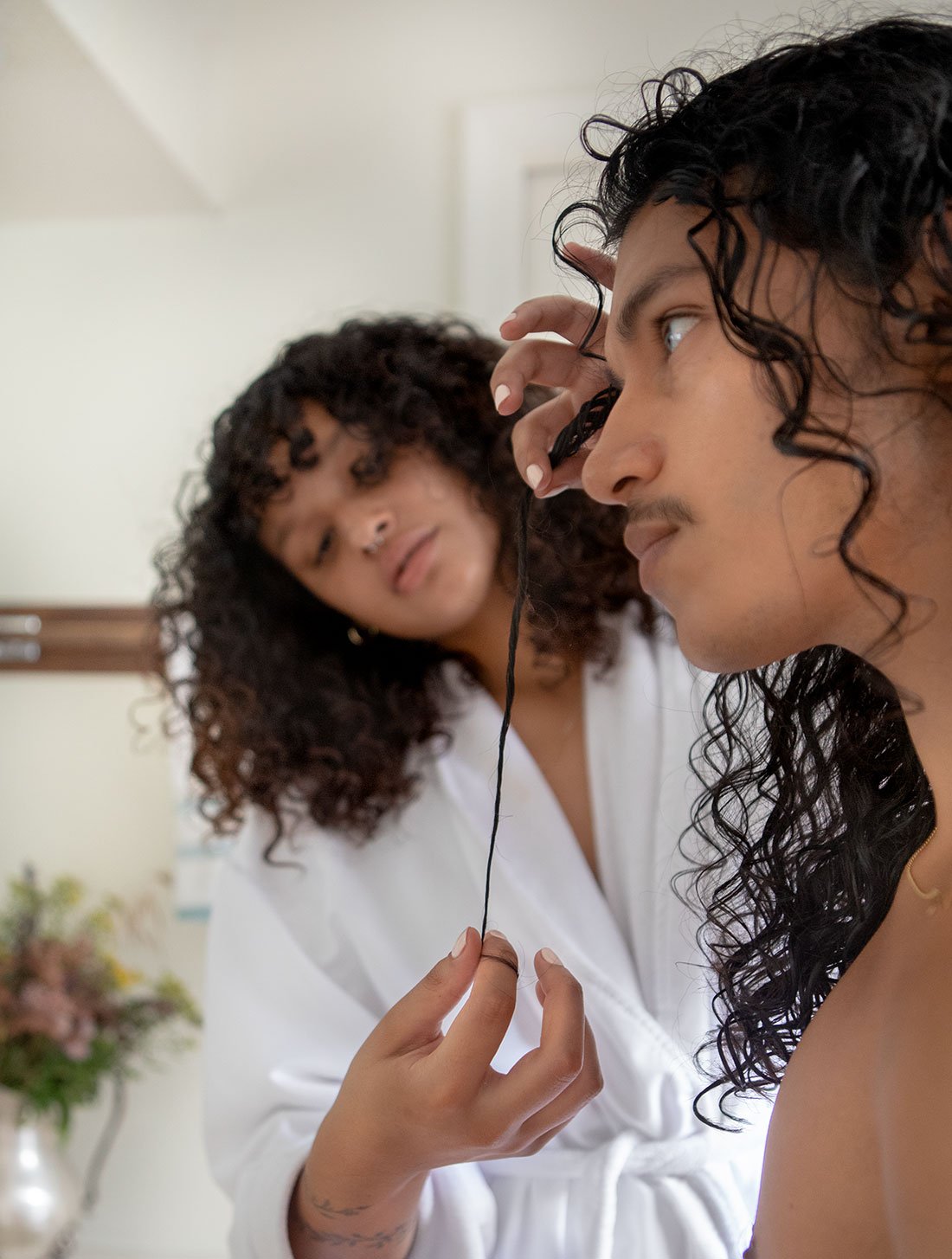Straight, wavy, curly, coily or even a combination of the few, we’ve all been there, frozen in the hair care aisle at your favorite beauty store, staring blankly at the overwhelming product variety. Understanding your hair type can alleviate some of the stress by recognizing your unique needs and can play a vital role in your healthy hair care journey in general.
With our recent launch of our very first for-hair-type product, The Pequi Curl Activator, we hope to guide you through your hair type discovery and, more specifically, the quite nuanced world of curl patterns.
What determines hair type?
As mentioned above, hair type is split into four main categories: Type 1-Straight, Type 2-Wavy, Type 3-Curly, Type 4-Coily. Each type is then split into three subcategories, ‘A’ through ‘C’. This refers to the hair thickness, or for wavy/curly types, refers to width of the curl or wave. ‘A’ hair types have the widest curl/wave, ‘B’ middle, and ‘C’ having the smallest or tightest curl/wave.
For those with Type 1-Straight and Type 2-Wavy, the subcategories refer to hair thickness; ‘A’ being thinnest and smooth, ‘C’ being thickest and coarse.

Type 1: Straight
1A - Thinner, smooth, soft, often lacks volume
1B - Slightly thicker, slightly more voluminous
1C - Thick and coarse
Type 2: Wavy
2A - Thin and wavy
2B - Slightly thicker and wavy
2C - Thick and wavy
Type 3: Curly (or ‘S’ pattern curls)
3A - Loose, wide curls
3B - Medium width curls
3C - Tight, small curls
Type 4: Coily (or zig-zag pattern curls)
4A - Soft
4B - Coarse, wiry
4C - Extremely wiry
Hair type vs. hair texture
While hair type speaks to the form or shape of your hair (I.e. Straight, curly, coily), hair texture refers to your individual strand characteristics, typically in three categories. Are your strands fine, medium or thick? If your individual strand is thinner than a piece of sewing thread it’s considered fine. If it’s thicker, it’s considered coarse and medium if it’s about the same size as the thread.
Hair texture is an important factor for understanding how your hair will behave to certain products and treatments, as well as knowing how to best care for your hair, ensuring it remains healthy through the elements, products and styling.
Fine hair tends to be less porous, allowing oil to sit atop the strand and becoming noticeably more visible much quicker than other coarser textures. On the flipside, coarse strands tend to lack moisture and become drier faster.

Identifying what’s best for your hair type
Although type 1 can often be susceptible to more grease, you’ll want to avoid overwashing to prevent your scalp from producing excess sebum. Instead, find a good dry shampoo for those in between wash days. Type 1A and 1B can also be prone to breakage. Use a lightweight leave-in conditioner for hydration and stick to a wide-toothed comb, especially on wet hair, to prevent further damage.
For type 2 waves and very loose curls, it’s a good idea to focus on products that are lightweight and have an activating curl hold to maintain a good bounce. We recommend washing every 2-3 days if you are 2A/2B and 3-5 days if you are 2C. Might we suggest our Pequi Curl Activator?
When it comes to type 3, we are talking truly curly. You know, the classic, spiraly, bouncy curls, typically ‘S’ shaped curls. For this type of curl, balanced moisturization is key, as they can get dried out quickly, which leads to excess frizz — Pro tip: stay away from sea salt products. We recommend washing only once per week and co-washing in between (washing with only conditioner), if necessary. You should also deep condition at least once a week and aim for lightweight oils to lock in moisture.
Type 4 includes very tight, coily, and oftentimes, textured curls. This curl pattern can resemble a C or Z pattern. For these curls, deep hydration and protection are essential. We also highly recommend staying away from silicones if you fall into this category. Although, we recommend avoiding silicones no matter your hair type…
A true for-all types formula, our Aceite de Moska scalp treatment may be the solution for you, whether it’s hydration, nourishment, shine or anti-frizz you’re after!
Why does hair change?
There are a number of factors that can alter your hair characteristics over time—some totally preventable and others not as much. Some things to consider when noticing a change in your hair:
- Environmental — If you live in an urban area or where pollution may be higher than usual, you may experience a lack in hair shine, texture or growth. Try a ph-spray for hair or a product that works to seal the cuticle, preventing pollutant penetration.
- Hormones — Hormonal changes from things like pregnancy, post-partum, menopause or certain birth controls can play a role in your hair changing. Be sure to take extra care in scalp and hair nourishment, especially as you age.
- Diet — Ensuring you are getting enough protein and essential fatty acids, like omega-3, is vital to maintaining healthy hair and skin.
- Hair Cycles — Every three to five years our hair renews its hair cycle, which can impact everything from hair texture to curl pattern.
As a general rule of thumb... Know before you go. Understand your hair needs based on your hair type to avoid products that aren’t right for you and over-buying. Most products are not suitable for all hair types, so be sure to do your research and read customer testimonials for inspo.
Our Aceite de Moska pre-shower and Pequi Curl Activator post-shower are the ultimate duo for keeping your curls and waves detangled, moisturized, and activated.





